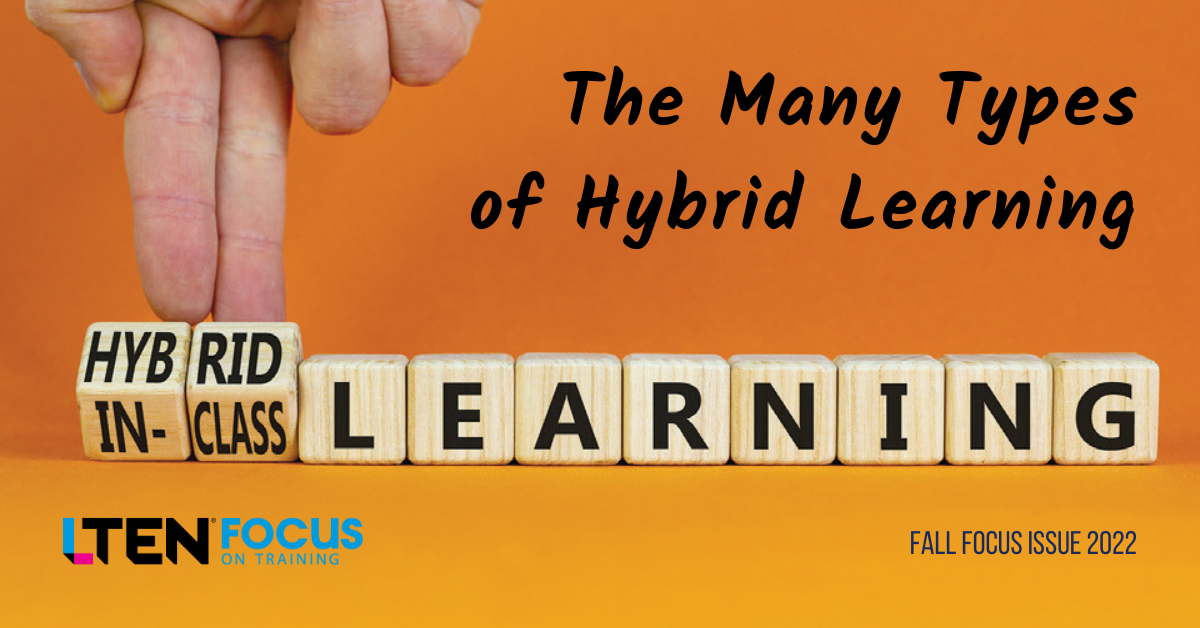
VIRTUAL TRAINING – Cindy Huggett, CPTD
The learner experience is key to success with this evolving trend
 Over the past several years, I’ve surveyed thousands of global training professionals to find out their experiences with virtual learning. My annual survey questions uncovered common data such as what’s the typical number of participants in a virtual class (less than 25) and how many use a producer (49%).
Over the past several years, I’ve surveyed thousands of global training professionals to find out their experiences with virtual learning. My annual survey questions uncovered common data such as what’s the typical number of participants in a virtual class (less than 25) and how many use a producer (49%).
My analysis often reveals emerging trends in virtual learning, such as the burgeoning use of virtual reality simulations folded into online classes, and the explosion of video use over time.
In my 2021 annual survey, I asked about hybrid learning for the first time. In response to the question “What is your organization’s plan for hybrid learning,” a whopping 67% said they were either already doing it or planning to do it soon.
So with this massive migration from purely virtual training to hybrid learning, I set out to explore this trend in more detail. I was curious about what’s happening with it and more importantly, how to implement it well. Here are my key findings.
What’s Hybrid Mean?
First, and perhaps most importantly, “hybrid learning” means different things to different people. In a higher education or university setting, hybrid refers to a learning program that combines synchronous and asynchronous components. But in the corporate world, we call that “blended learning.”
In workplace learning – and the definition that I clearly noted in the 2021 survey – hybrid learning is a synchronous event that has a mixture of participant locations: some together onsite, others remote onsite. Interestingly, the higher-education world calls that experience a “hy-flex” class.
The takeaway? Pause to define exactly what your organization means by hybrid learning. Get on the same page so that expectations are established among all stakeholders.
What Does It Look Like?
Next, if your organization decides to implement hybrid learning, determine how you will set it up. In other words, what exactly does it look like? In a 2022 follow-up “pulse” survey of almost 200 global learning professionals, I asked about hybrid learning formats with the following options:
- Most participants are co-located in-person with some joining remote: 31%
- Most participants are remote with a few colocated in-person: 32%
- Two (or more) co-located in-person groups meet together (for example, 10 participants together in a room and 10 participants together in another room): 8%
All the above instances qualify as hybrid learning. But each one has nuances that could impact the success of the learning experience. If most participants are together, you can design the program to be more like a traditional in-person class. But if most participants are remote, then you’ll need to focus on the virtual components.
Again, as an organization, determine your parameters and expectations for hybrid learning.
Equalize the Learning
Third, a hybrid learning best practice is to create a shared experience for all participants, regardless of their location. In the same pulse survey mentioned above, only 34% of respondents said that all hybrid class participants use a device to connect online. If the goal is to bridge the gap between in-person and remote audiences, then this percentage needs to be much higher.
To equalize the learning experience for all attendees, each participant should have access to the same tools.
One example is to ensure that everyone can be seen on camera during class discussions. So, the inperson group would be in a cameraenabled classroom, and the remote participants would be on webcam. In addition, when each participant has a connected device, everyone will benefit from the ability to collaborate. Each participant has an equal opportunity to type in chat, vote in polls and contribute to whiteboards.
To make this work well, your organization may need to invest in hybrid room technologies (cameras, screens and quality audio connections). At minimum, your organization should establish the expectation of accessibility to hybrid tools.
What’s Your Plan?
Finally, determine your plan for facilitation support. In my follow-up conversations with learning professionals, the common assumption is that the facilitator will be on site with the in-person participants. In some circumstances it may be acceptable for the facilitator to be remote. From my own experience, it’s preferable to be with the majority of the participants, and if that’s remote, to have an in-room monitor for support.
Either way, it shouldn’t be a haphazard decision. Intentionally determine where the facilitator will be so that they can effectively support participant learning.
Conclusion
Hybrid learning is still an evolving trend without a clearly established pathway to success.But we know that in order to do it well, the learner experience must be paramount. It takes careful advance planning with appropriate technology support.
Cindy Huggett, CPTD, is a consultant whose books include Virtual Training Tools and Templates and The Virtual Training Guidebook. Email her at cindy@cindyhuggett.com.








